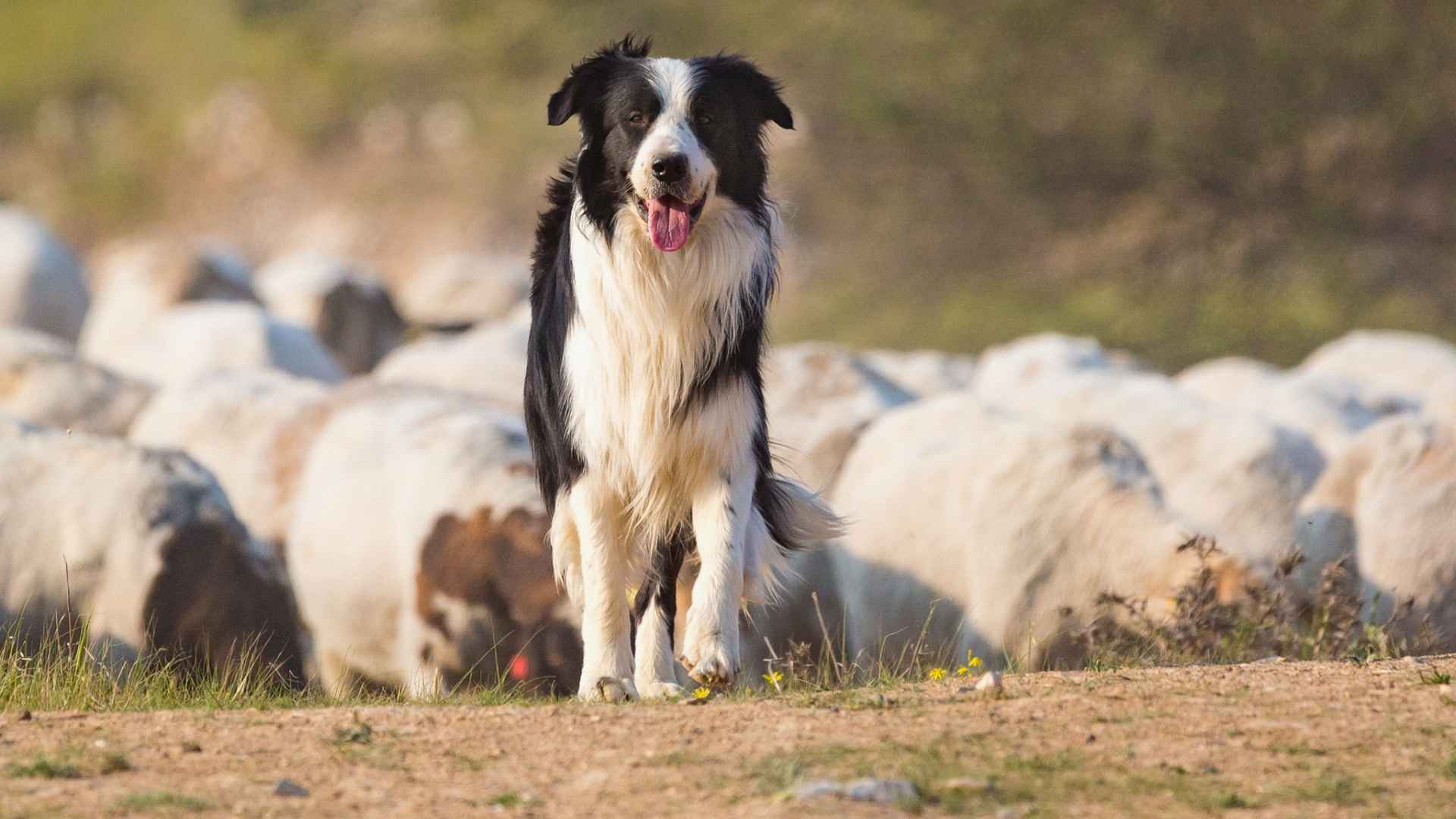Life on the farm demands more than just hard work—it calls for determination, agility, and unwavering loyalty. That’s where cattle dog breeds shine. These incredible working dogs are bred for a purpose, whether it’s chasing down stubborn cows through dense brush or standing guard over a grazing herd.
From sunrise to sundown, their instincts kick in to move, protect, and manage livestock with expertise that no tool or machine can truly match. Originally grouped under the AKC Working category until 1983, these dogs are now proudly recognized as part of the Herding Group—an acknowledgement of their natural ability to control the movement of other animals.
Breeds like the Australian Cattle Dog, Border Collie, and Belgian Malinois don’t just work the land—they live for it. Intelligent, loyal, and highly trainable cattle dog breeds make dependable partners on the farm and loving companions at home. Let’s meet the herding experts behind the scenes.
Cattle dog breeds
1. Australian cattle
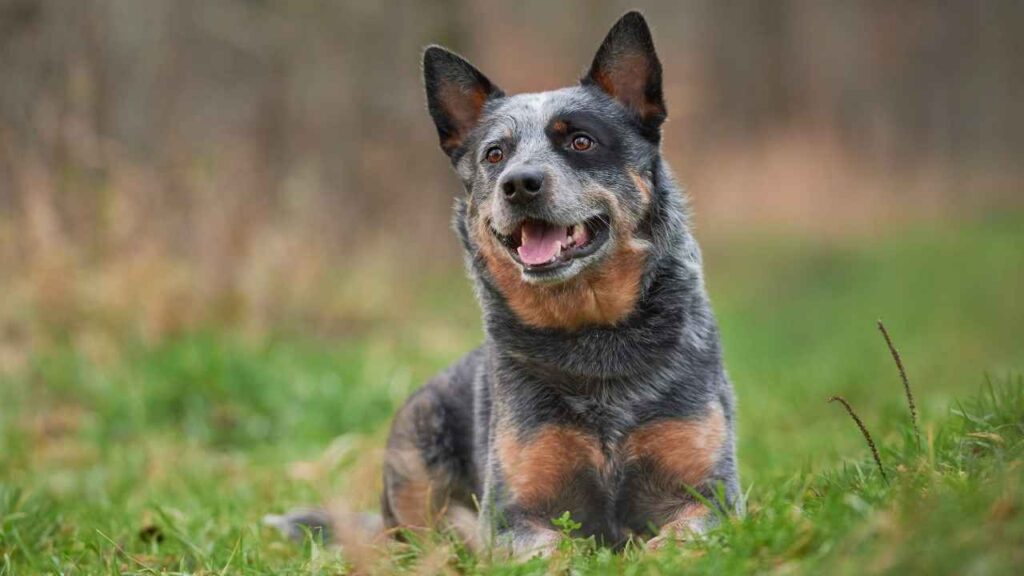
The Australian Cattle Dog, also known as the Blue Heeler or Queensland Heeler, was bred to control large herds of unruly cattle across the harsh terrain of the Australian outback. These tough, agile dogs earned their nickname by nipping at the heels of livestock to keep them moving.
Developed in New South Wales by breeders like Harry Bagust, the breed was refined using Dalmatians for loyalty and black mouth Curs for tenacity. Their evenly speckled coats in blue or red, often accented with tan markings, give rise to their nicknames—“blue dogs” and “red dogs.”
Compact, muscular, and alert, they sport upright ears and a dense double coat that comes in eye-catching red or blue patterns, built for both beauty and utility. Interestingly, Blue Heeler puppies are born white, gradually developing their unique speckled or mottled coloring as they grow.
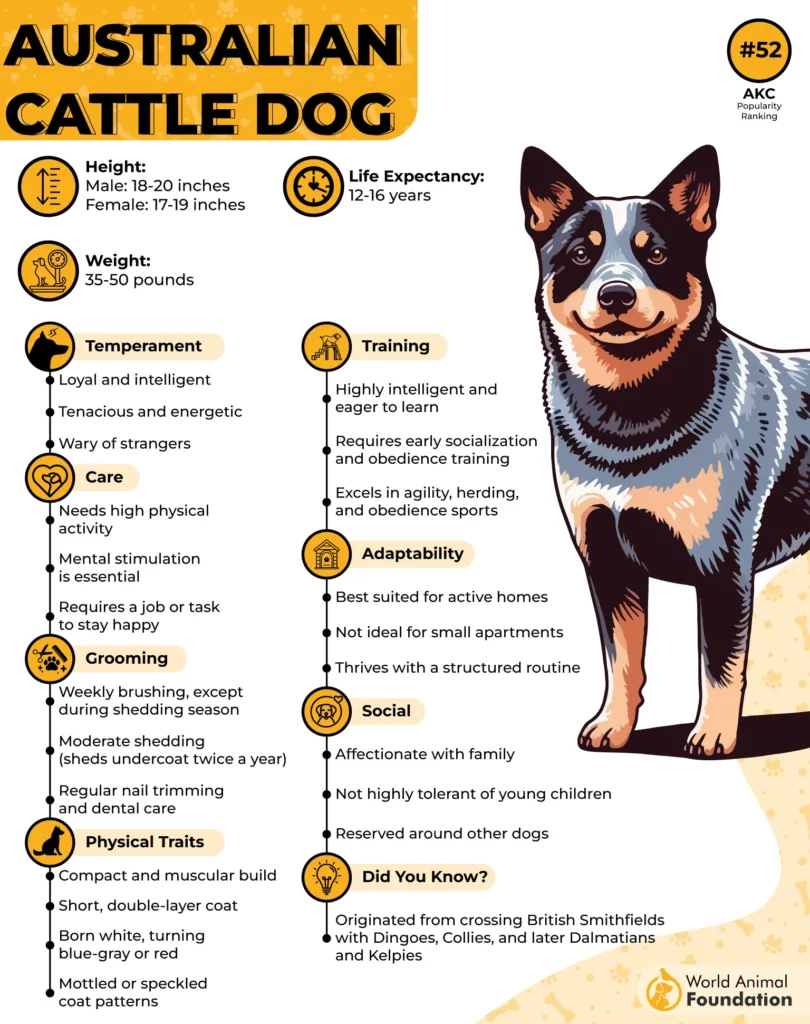
Known for forming strong bonds, Aussie Cattle Dogs are devoted “shadow dogs” who hate being left alone. They thrive on activity and companionship—whether it’s running, hiking, or a quick outing. Without enough exercise and mental stimulation, they can become bored and destructive.
Highly intelligent, loyal, and protective, Australian Cattle Dogs make excellent watchdogs but may be too energetic for very young children or seniors unless properly trained. For active, outdoors-loving owners, they can be the perfect, devoted companion.
Their natural herding instinct means they may try to herd anything that moves, including kids, so setting clear boundaries is important. Though independent and headstrong at times, they are quick learners with patient guidance.
As noted by Australian Cattle Dog Club (ACDCA), this breed is highly trainable and eager to please, often mastering tasks after just a few exposures. With proper training, one Cattle Dog can do the work of two or three skilled riders.
Fun Fact:
An Aussie Cattle Dog named Bluey holds the world record as the oldest dog ever, living an astonishing 29 years and 5 months! Talk about legendary longevity.
2. Australian Shepherd
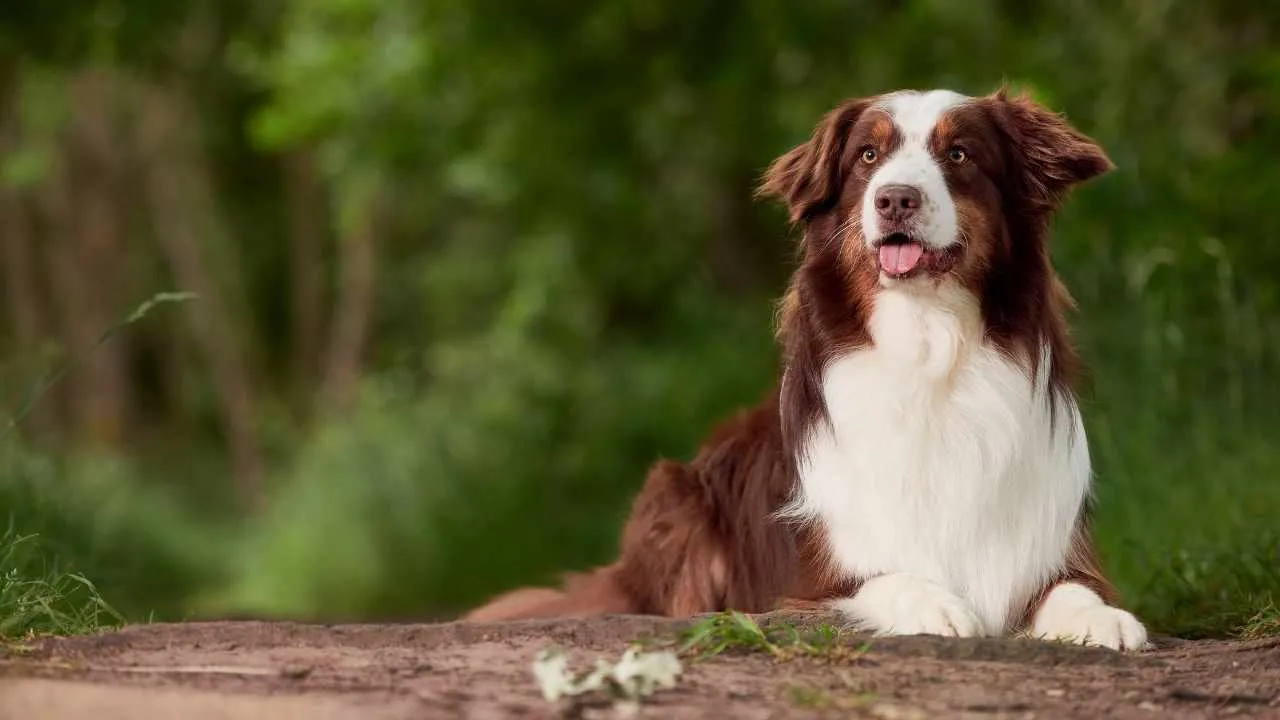
The Australian Shepherd, or Aussie, is a medium-sized powerhouse with a sleek, athletic build and a beautiful medium-length coat. Despite the name, this clever breed actually originated in Europe and came to the U.S. through Australia.
Known for their intelligence, loyalty, and hardworking nature, Aussies are perfect companions for active families and outdoor lovers.
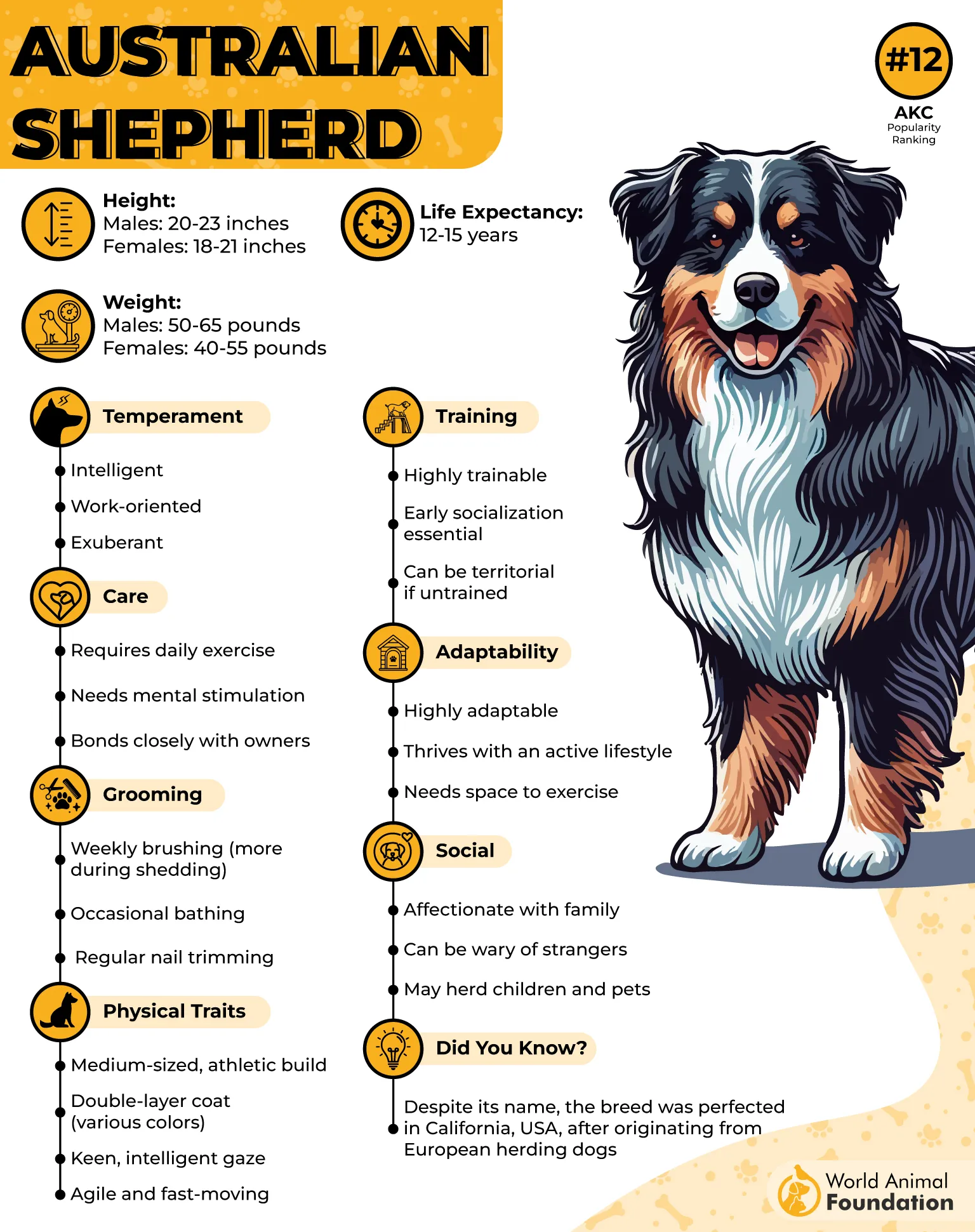
Smart and alert, Australian Shepherds are quick learners with a bit of independence. They require owners who can match their high energy levels and provide consistent mental and physical stimulation.
Working-line Aussies can be demanding, so they’re best for dedicated owners. They may be cautious with strangers and bossy with other dogs, making them excellent watchdogs with a vocal streak.
American Kennel Club (AKC) states Aussies thrive when given plenty of mental and physical exercise—an hour or more daily is ideal. They excel in activities like herding, agility, obedience, and dock diving.
While they enjoy a well-fenced yard, they aren’t prone to escaping. They prefer cooler climates and need regular brushing during shedding season to keep their coat in top shape.
Fun Fact:
You’ll often find Aussies on the rodeo circuit, living up to their cowboy cred as favorite herders on ranches. They truly embody the spirit of the American West!
3. Border Collie
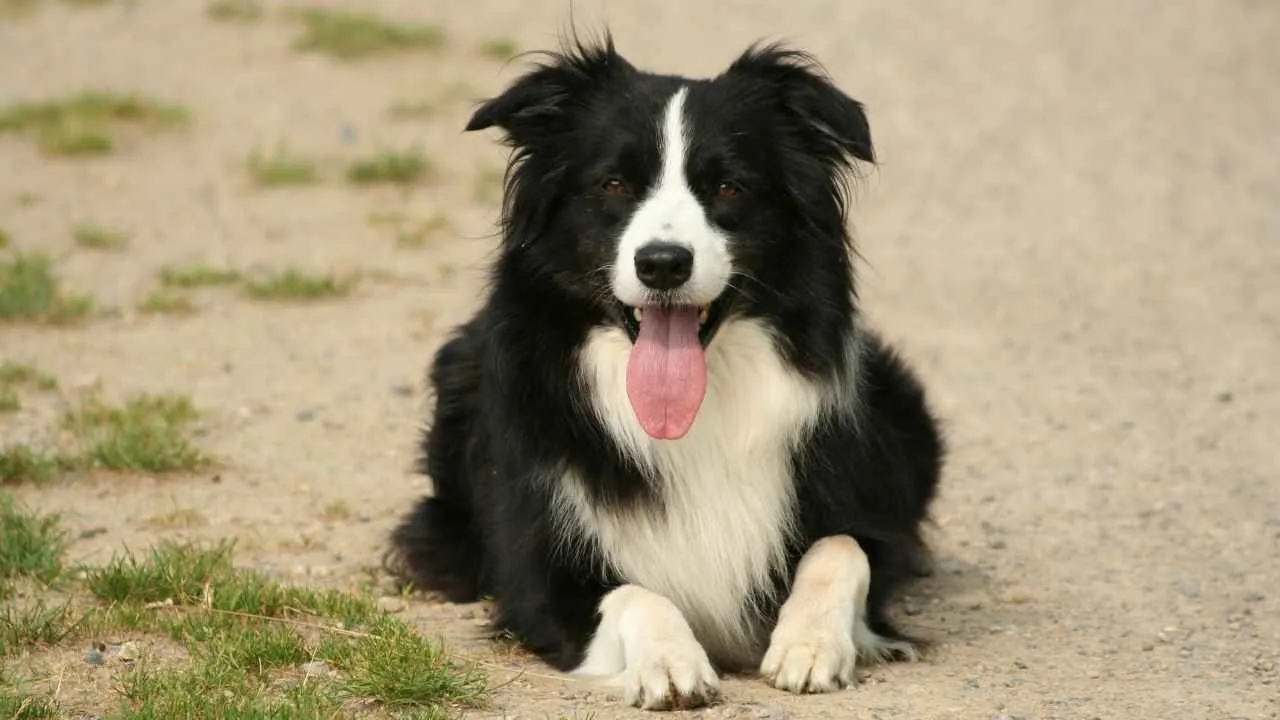
The Border Collie is a herding genius with over 300 years of experience from the borderlands between England and Scotland. Famous for their intense “eye,” they can move entire flocks with just a focused stare and a few signals. This breed’s precision and drive are unmatched, making them invaluable on farms worldwide.
Built for hard work, Border Collies descend from Roman and Viking herding dogs. Agile and eager to please, they instinctively know how to manage sheep, cattle, goats, and even chickens. Their favorite tactic is to head off the herd and keep everyone in line—a natural talent that makes them outstanding farm helpers.
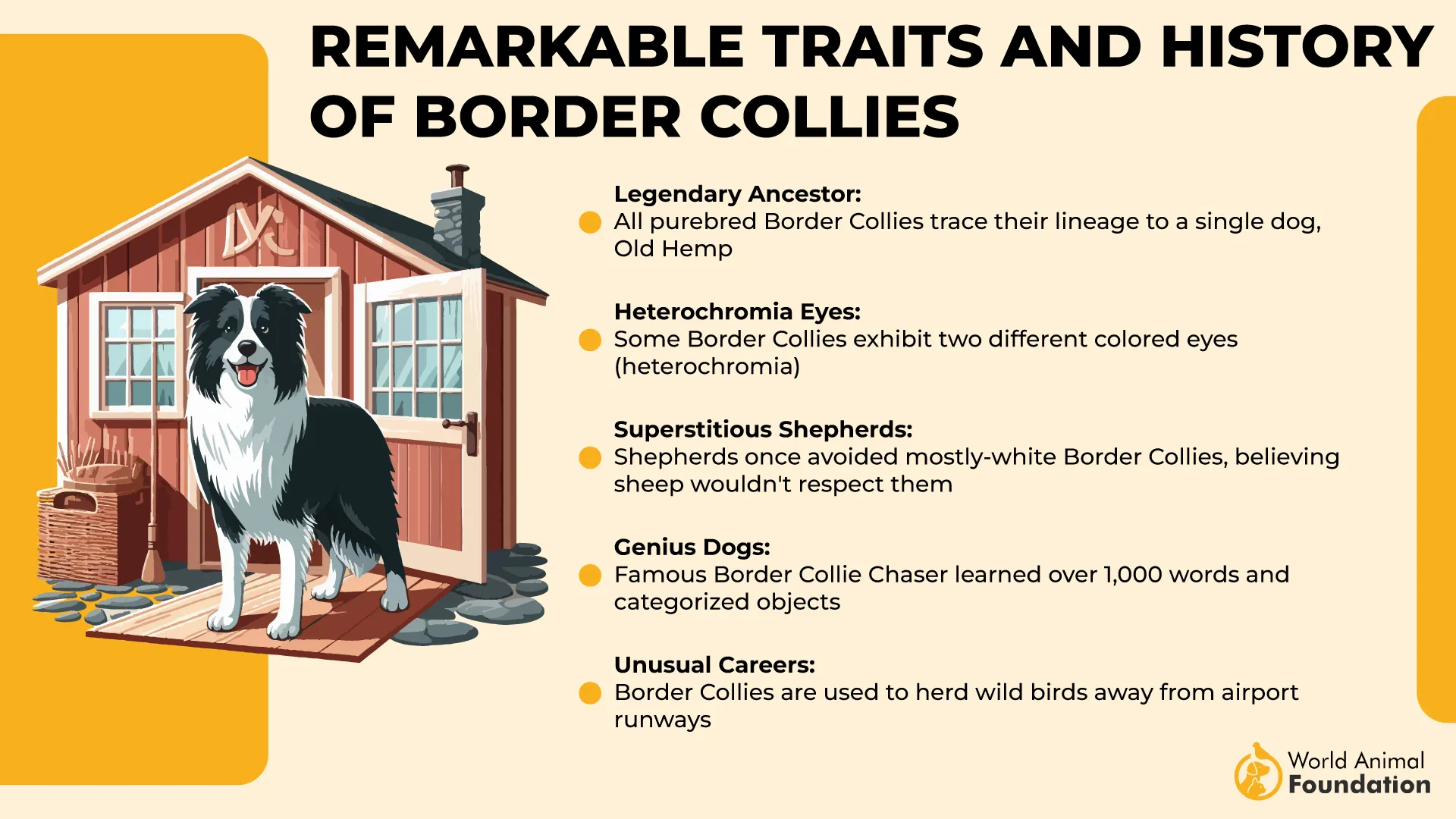
Border Collies often show herding instincts early on, but formal training usually starts between six and twelve months. While they learn quickly on the job, structured training sharpens their skills, turning them into top-notch farm workers or dog sports stars. They aren’t built for downtime—they need constant mental challenges and plenty of exercise to stay happy.
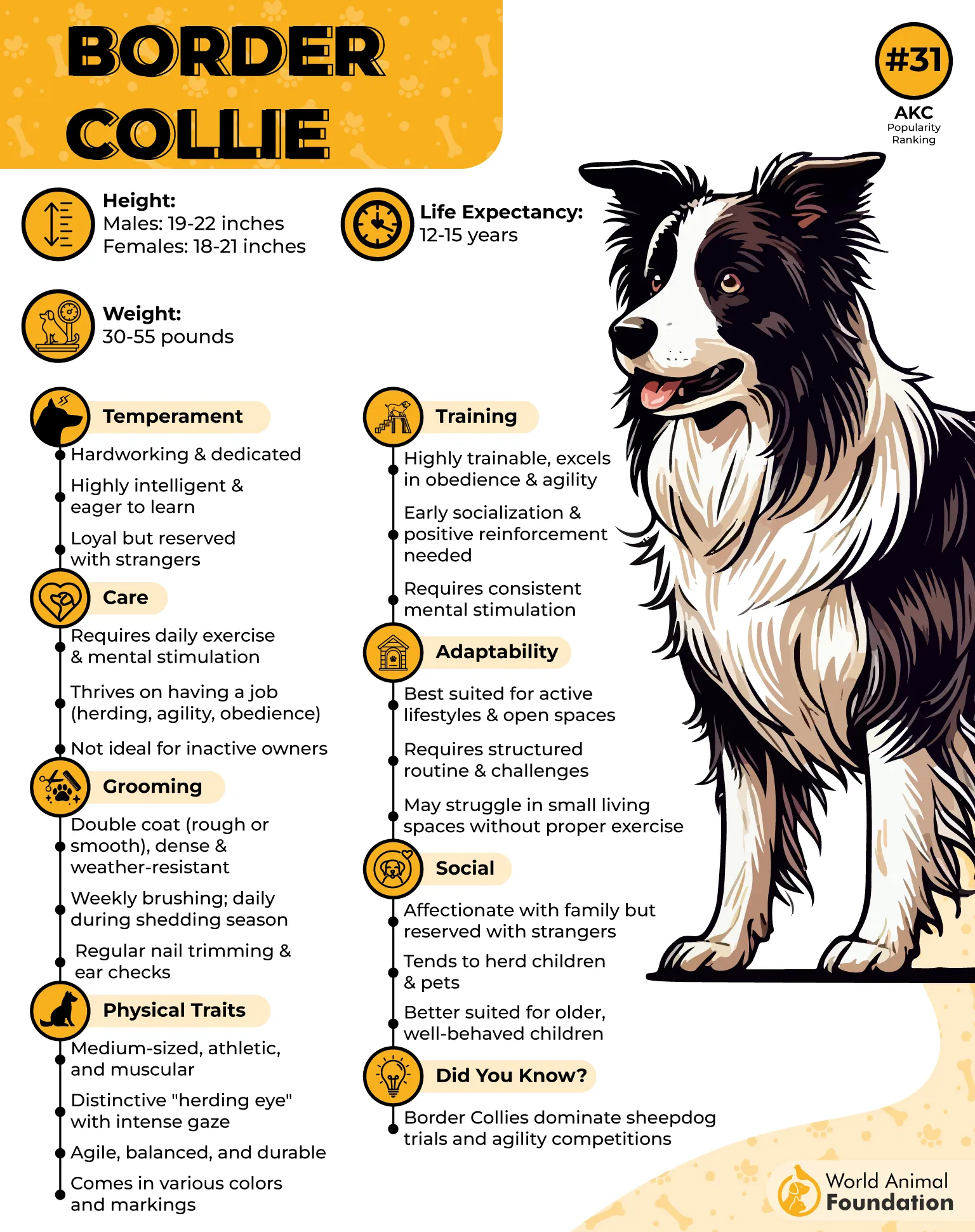
Typically sporting a long, flowing coat in black-and-white or eye-catching merle, these dogs turn heads as easily as they herd. Their expressive eyes, sometimes mismatched in color, add to their striking appearance. Regular grooming is a must, especially during shedding season, but the effort is well worth it.
Fun Fact:
A Border Collie named Chaser made headlines as the “world’s smartest dog” by learning the names of over 1,000 objects. These dogs aren’t just top herders—they’re canine record-breakers!
4. Australian Kelpie
The Australian Kelpie is a high-energy powerhouse bred for the harsh conditions of the Outback. With sharp instincts and fierce focus, these dogs handle livestock—and even a busy household of kids—with ease. Their legendary ability to work independently over large areas has made them trusted partners for farmers worldwide.
Bred to think quickly and act independently, Kelpies can be a bit headstrong but are naturally alert and watchful. This makes them excellent watchdogs who are cautious around strangers without being overly aggressive.
Despite their hardworking nature, Kelpies are affectionate family dogs who bond closely with their people. They enjoy cuddles after a day full of activity, but may try to herd family members, so early training to manage that instinct is helpful. With guidance, they become loyal companions who love active homes.
Smart and agile, Kelpies excel in activities like agility, flyball, and obedience. They thrive on having a job and plenty of mental challenges. Without enough stimulation, their clever minds can lead to mischief, so puzzle toys and herding games are essential to keep them busy and happy.
To keep a Kelpie content, daily physical exercise like long walks and off-leash runs is a must, alongside mental stimulation. Engaging them with training, games, or new tricks keeps their minds sharp and rewards owners with unwavering loyalty and impressive skills.
5. Cardigan Welsh Corgi
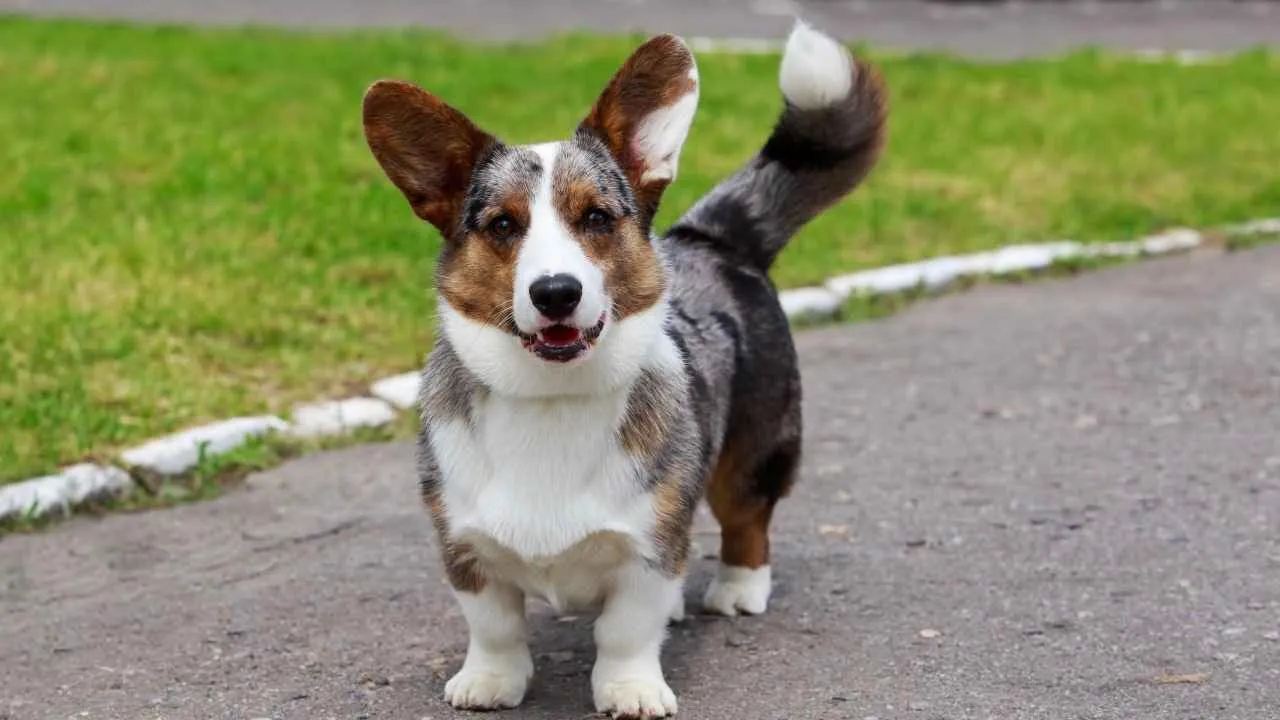
Say hello to the Cardigan Welsh Corgi, affectionately known as the Cardi—a sturdy little dog with foxy features and a famously fluffy, wagging tail. These short-legged charmers hail from Wales, where they worked as herders and barnyard helpers. Unlike their Pembroke cousins, Cardigans sport long tails and a more robust build that makes them uniquely endearing.
Originally bred to herd cattle, their low stature helped them dodge kicks from hooves. While their working days are mostly behind them, that strong drive remains. After nearly disappearing in the 18th and 19th centuries, dedicated breeders revived the breed. Today, whether lounging on the couch or hitting the trails, Cardigans pack plenty of personality into their compact frame.
Though often called perfect companions for older adults, Cardigans shine with families too. They’re gentle, loyal, and get along well with kids, other pets, and even cats. Easy to train and not prone to excessive barking or wandering, they’re relaxed yet reliable housemates—though they might try to herd everyone in the living room!
Don’t be fooled by their short legs—Cardigans have plenty of energy and stamina. They excel in agility, flyball, and herding trials thanks to their quick minds and eagerness to please. Regular walks, backyard play, and games like fetch keep them happy and out of trouble. Mental challenges are a must to prevent boredom-driven mischief.
WebMD states that Cardigans are generally healthy but can be prone to hip dysplasia, retinal issues, and spinal problems, especially if overweight. Routine vet visits and a balanced diet help keep them in top shape. Their double coat sheds, so daily brushing is key to managing fluff and keeping your furniture fur-free.
6. Pembroke Welsh Corgi
With their low-slung bodies and big personalities, Pembroke Welsh Corgis are pint-sized powerhouses. Bred in Wales to herd livestock and help on farms, these sturdy and smart dogs are deeply devoted to their humans. Most are tailless, giving them that iconic Corgi wiggle that fans can’t get enough of.
Don’t be fooled by their short legs—Pembrokes are an athletic and hardworking herding breed, built to hustle with surprising agility and independence. Standing just 10–12 inches tall and weighing around 27–30 pounds, they have the heart and energy of much bigger dogs. Whether sprinting around the yard or excelling in training, they’re always ready for action.
Affectionate and playful, Corgis thrive when given a job—whether that’s fetching, learning tricks, or simply being by your side. They adapt well to apartment or country living but need regular exercise and mental stimulation to stay happy. Without it, they can become vocal and bossy little troublemakers.
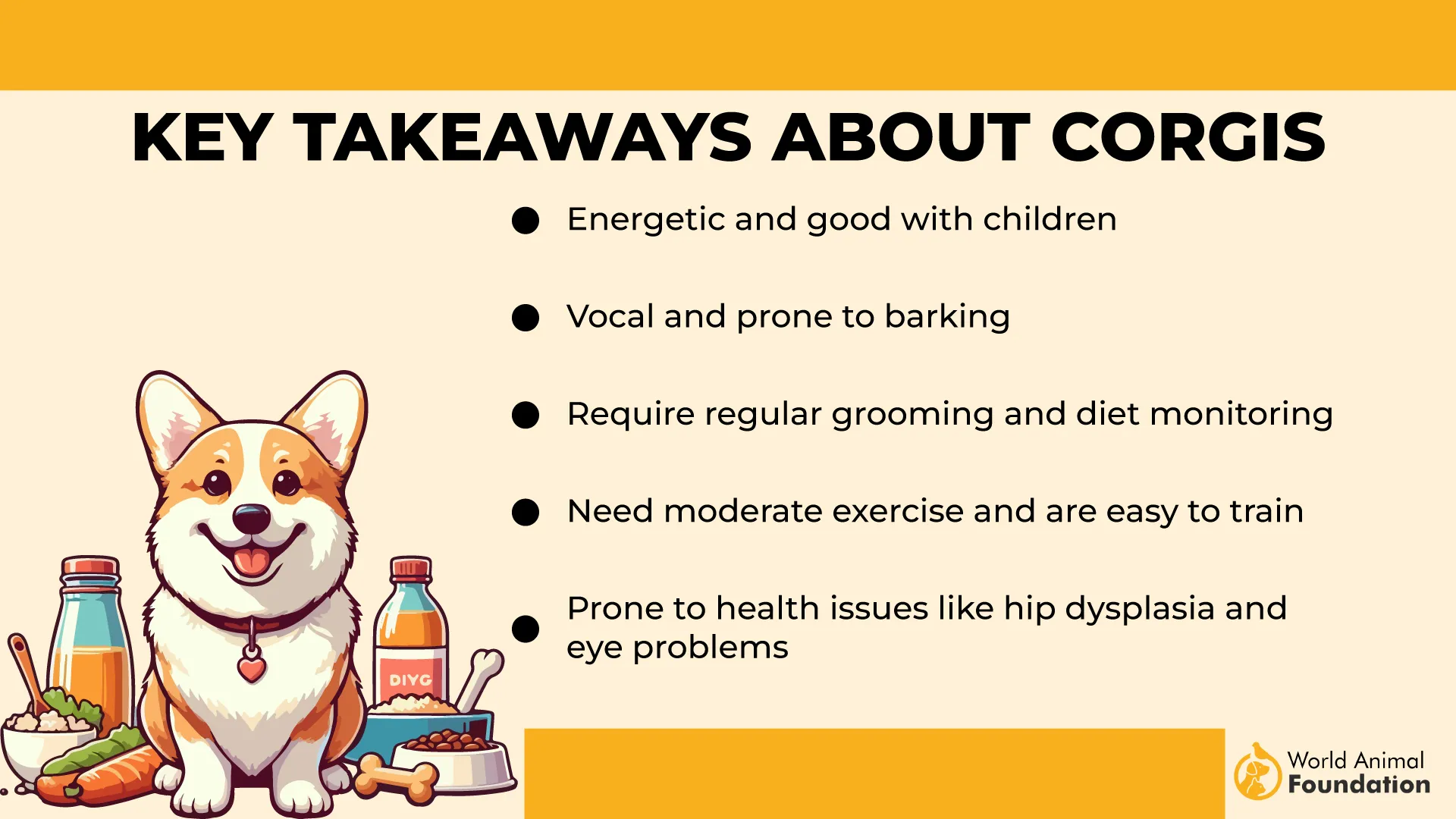
Smart and independent, Pembrokes can be a bit stubborn, making training a fun challenge. They respond best to positive reinforcement and consistency, while early socialization helps manage their natural herding instincts, which sometimes extend to rounding up kids or guests.
If you want a clever, lively, and loyal companion who brings laughter and maybe a bit of herding sass to your life, the Pembroke Welsh Corgi could be your perfect match. With the right balance of exercise, training, and love, these little royals will win your heart and home.
Fun Fact:
Pembrokes were a favorite of Queen Elizabeth II, who received her first Corgi, Dookie, in 1933 and went on to own over 30 during her lifetime. In her later years, she stopped breeding them to avoid leaving behind dogs after her passing.
7. Swedish Vallhund
Say hej to the Swedish Vallhund—a small yet sturdy herder with Viking roots and a big personality. Compact and athletic, these pups sport a dense double coat in shades from gray to reddish-brown. Their wedge-shaped heads, sharp ears, and curious eyes give them an alert, ready-for-anything look. Tails vary—some are naturally bobbed, others long and expressive.
Bred over a thousand years ago to herd cattle in Sweden, Vallhunds are confident and capable. They drive livestock with quick darts, sharp barks, and the occasional nip, relying on their low build and agility to stay clear of danger. Smarts match their courage—they work with intensity but never recklessness.
Despite their work-first attitude, Vallhunds are affectionate and fun-loving at home. They’re famously vocal, expressing themselves with a mix of barks, whines, and groans. It’s not drama—it’s their way of staying connected and involved.
Vallhunds thrive with structure, exercise, and mental challenges. They’re fast learners, though their clever minds need variety to stay engaged. Left to their own devices, they’ll invent games—like barking at shadows or sorting your laundry. Early training helps channel their energy, especially around kids or other pets.
Once properly socialized, Vallhunds become highly loyal and excellent companions. They might be reserved at first with new people or dogs, but with patience, they warm up and reveal their affectionate, expressive nature.
Fun Fact:
These Viking-born dynamos have not only herded cattle for centuries—they’ve also graced postage stamps in countries like Sweden, Russia, Ukraine, and even Nicaragua. That’s right, your pup could’ve been a cover model!
Conclusion
Cattle herding dog breeds are more than just skilled workers—they’re loyal dogs devoted to their people and purpose. Whether it’s a German Shepherd Dog guarding the perimeter, a Kelpie driving cattle across rugged terrain, or a Border Collie managing other livestock with precision, these breeds are essential partners on a working farm.
Bred to meet specific breed standards upheld by each parent club, these dogs thrive when given meaningful farm work and clear direction. Their natural instincts to protect livestock, work cattle, and even coexist with horses make them invaluable on a daily basis. With the right training and environment, these herding experts are not just helpers—they’re part of the family.


